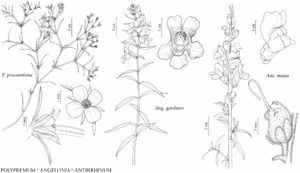Difference between revisions of "Antirrhinum majus"
Sp. Pl. 2: 617. 1753.
FNA>Volume Importer |
FNA>Volume Importer |
||
| Line 34: | Line 34: | ||
|elevation=0–2000 m. | |elevation=0–2000 m. | ||
|distribution=B.C.;Ont.;Que.;Calif.;Conn.;D.C.;Ill.;Iowa;La.;Mass.;Mich.;Mo.;N.Y.;Ohio;Oreg.;Pa.;Utah;Vt.;Va.;Wash.;Wis.;sw Europe;introduced also in Mexico;West Indies;Central America;South America;Asia;Africa;Australia. | |distribution=B.C.;Ont.;Que.;Calif.;Conn.;D.C.;Ill.;Iowa;La.;Mass.;Mich.;Mo.;N.Y.;Ohio;Oreg.;Pa.;Utah;Vt.;Va.;Wash.;Wis.;sw Europe;introduced also in Mexico;West Indies;Central America;South America;Asia;Africa;Australia. | ||
| − | |discussion=<p>Antirrhinum majus is a popular garden plant grown as an annual; it occasionally escapes but is short-lived. Some cultivars have been developed with different growth forms, corolla colors, or open-throated flowers.</p> | + | |discussion=<p><i>Antirrhinum majus</i> is a popular garden plant grown as an annual; it occasionally escapes but is short-lived. Some cultivars have been developed with different growth forms, corolla colors, or open-throated flowers.</p> |
|tables= | |tables= | ||
|references= | |references= | ||
| Line 59: | Line 59: | ||
|publication year=1753 | |publication year=1753 | ||
|special status=Weedy;Introduced;Selected by author to be illustrated | |special status=Weedy;Introduced;Selected by author to be illustrated | ||
| − | |source xml=https://jpend@bitbucket.org/aafc-mbb/fna-data-curation.git/src/ | + | |source xml=https://jpend@bitbucket.org/aafc-mbb/fna-data-curation.git/src/8f726806613d60c220dc4493de13607dd3150896/coarse_grained_fna_xml/V17/V17_84.xml |
|genus=Antirrhinum | |genus=Antirrhinum | ||
|species=Antirrhinum majus | |species=Antirrhinum majus | ||
Revision as of 16:03, 18 September 2019
Stems terete, 3–8(–15) dm, glabrous or sparsely stipitate-glandular proximally, stipitate-glandular distally. Leaves: blade narrowly elliptic to lanceolate, 50–70 × 5–20 mm, glabrous or sparsely stipitate-glandular proximally. Inflorescences stipitate-glandular, sometimes glabrous; bracts similar to distal leaves. Pedicels 1–7 mm, stipitate-glandular. Flowers: sepals 5–10 mm, stipitate-glandular; corolla palate yellow; filaments 20–40 mm. Capsules 7–10 mm wide. 2n = 16 (Europe).
Phenology: Flowering May–Oct.
Habitat: Disturbed ground.
Elevation: 0–2000 m.
Distribution
B.C., Ont., Que., Calif., Conn., D.C., Ill., Iowa, La., Mass., Mich., Mo., N.Y., Ohio, Oreg., Pa., Utah, Vt., Va., Wash., Wis., sw Europe, introduced also in Mexico, West Indies, Central America, South America, Asia, Africa, Australia.
Discussion
Antirrhinum majus is a popular garden plant grown as an annual; it occasionally escapes but is short-lived. Some cultivars have been developed with different growth forms, corolla colors, or open-throated flowers.
Selected References
None.
